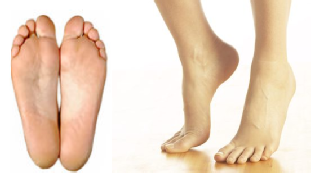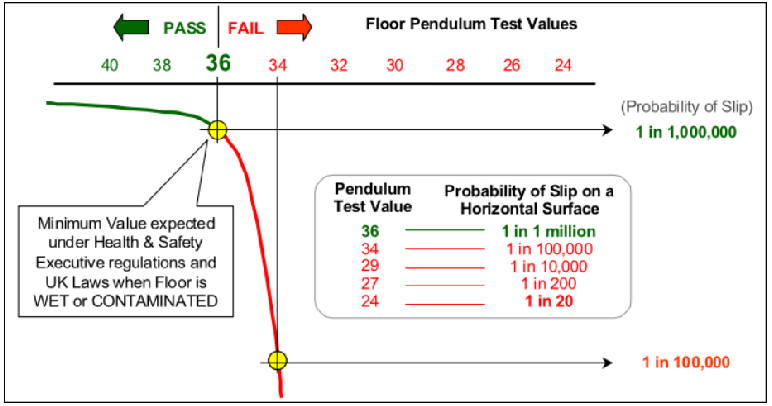

UK Specialists in H&S Approved Floor Pendulum Testing for Businesses
and CPR 35 / COPFS Expert Witness Services for Slip Injury Lawyers
FloorSlip

You are here >

Comments from Our Customers … “FloorSlip is a great source for Floor Safety expertise and Floor Pendulum Testing” … “The CPR35/COPFS Expert Witness reports for Slip Injury Lawyers are clear, unequivocal, affordable and assist in winning Slip Injury Claims”
Floor Slip R Ratings - What is the Floor ‘R Rating’?
The slip resistance of floor surface materials are often classified on the basis of ‘DIN standards’*, which is a European Standard of Testing widely used and adopted by the UK for ‘Floor Slipperiness Classification’. The Floor R Rating values are determined by DIN 51130 ‘Ramp Testing’ to identify when a person walking will slip and fall. The method is to determine when a person slips whilst wearing heavily cleated EN:ISO 20345 Safety Boots shod with a sole and heel of a specific rubber hardness and with the floor contaminated with motor oil**. A person walks on a ramp and the ramp is gradually inclined to steeper angles until the person slips .
The R Rating is the value awarded dependent upon the slope angle the person slip and falls at
The R Rating starts at R9 (shallow slope angle) and goes through to R13 (steepest slope angle)
(The ‘R’ relates to the ‘R’ in Ramp Test)
* DIN is an equivalent to British Standard in the UK. It is an accepted standard in the UK. DIN stands for 'Deutsches Institut für Normung' or German Institute of Standardisation. It is the standard by which floor designers and architects specify to conform with building regulations and to offset possible Slip Accident Injury
** It has been our experience that oil and water or a mix thereof tend to give similar slip resistance values tested via the Pendulum Test Method

Important Caveat -
If you definitely need Ramp Testing then contact FloorSlip and we can advise you who to talk to
WHAT YOU NEED TO KNOW IN RESPECT TO FLOOR R RATINGS
Relationship of Floor R Ratings to Floor Pendulum Test Values
To make the ‘R Rating’ representative to multiple floor types (‘R Ratings’ are for a shod environment only*) it has been determined by the UK HSE in research (see links below) that the R Ratings are equivalent to the following range of Floor Slip Pendulum Test Values. Note -
*For Dedicated WET Floor environments such as Wet Rooms, Showers, Swimming Pools and Jacuzzies etc. use the DIN 51097 ABC Ratings -
DIN 51130 ‘R Ratings’ for SHOD Floor Environments
Table of Floor R Ratings FOR SHOD FEET with respect to the Pendulum Test Value at specific floor slope angles

Note -
IMPORTANT -
Din 51130 R Rating Classification R9 - Slippery When Wet in ALL Cases
Floor Slope Angle -
0 Degrees -
1 Degree -
2 Degrees -
3 Degrees -
4 Degrees -
5 Degrees -
6 Degrees -
Din 51130 R Rating Classification R10 - Slippery When Wet in ALL Cases
Floor Slope Angle -
0 Degrees -
1 Degree -
2 Degrees -
3 Degrees -
4 Degrees -
5 Degrees -
6 Degrees -
Din 51130 R Rating Classification R11 ‘Sometimes’ Slippery When Wet; Pendulum Test proves exact values
Floor Slope Angle -
R11 0 Degrees 34 to 51 PTV
1 Degree -
2 Degrees -
3 Degrees -
4 Degrees -
5 Degrees -
6 Degrees -
Din 51130 R Rating Classification R12 - First ‘R Value’ where 36 PTV always occurs. It is suggested (as a minimum) to Get the Floor / Floor Sample Pendulum Tested at 8 Degrees of slope or more to prove the exact value if slopes greater than 8 Degrees will be / are found
Floor Slope Angle -
0 Degrees -
1 Degree -
2 Degrees -
3 Degrees -
4 Degrees -
5 Degrees -
6 Degrees -
7 Degrees -
8 Degrees -
9 Degrees -
Din 51130 R Rating Classification R13 - 36 PTV always occurs - typical for wheelchair ramps but angles greater than 19 degrees will mean the value drops below the UK HSE Required 36 PTV to ensure a ‘Low Slip Potential’
Floor Slope Angle -
0 Degrees -
1 Degree -
2 Degrees -
3 Degrees -
4 Degrees -
5 Degrees -
6 Degrees -
19 Degrees -
Data Sources
http://www.hse.gov.uk/pubns/geis2.pdf
http://www.hse.gov.uk/SLIPS/step/education/Advanced/8E7F777B-
DIN 51097 ABC Ratings for BARE FOOT / WET Floor Environments
For dedicated WET Floor environments -
Table of Floor ‘ABC’ Ratings FOR BARE FEET with respect the Pendulum Test Value at specific floor slope angles

Note -
In all cases it is suggested to only use a Din 51097 ‘C’ Rating to ensure compliance with the HSE recommendation (expectations!) to achieve a low risk of slip.
It has been our experience that procurement of DIN 51097 Rated flooring products can be difficult to achieve. It is therefore suggested to aim at a high value ‘R Rated’ floor -
*International Rubber Hardness Degree
IMPORTANT -
Din 51097 Classification ‘A’ -
Floor Slope Angle -
0 Degrees 21 to 31 PTV
1 Degree 19 to 29 PTV
2 Degrees 18 to 28 PTV
3 Degrees 16 to 26 PTV
4 Degrees 14 to 24 PTV
5 Degrees 12 to 22 PTV
6 Degrees 11 to 21 PTV
Din 51097 Classification ‘B’ -
Floor Slope Angle -
0 Degrees 32 to 42 PTV
1 Degree 30 to 40 PTV
2 Degrees 29 to 39 PTV
3 Degrees 27 to 37 PTV
4 Degrees 25 to 35 PTV
5 Degrees 23 to 33 PTV
6 Degrees 22 to 32 PTV
Din 51097 Classification C - should be acceptable for predominantly WET areas - provided floors do not exceed 5 degrees of slope (and always allow a minimum of 10% or 4 PTV for wear, which will reduce the ability of a floor to resist slips)
Floor Slope Angle -
0 Degrees 45 PTV
1 Degree 43 PTV
2 Degrees 42 PTV
3 Degrees 40 PTV
4 Degrees 38 PTV
5 Degrees 36 PTV
6 Degrees 35 PTV
Source of data
http://www.hse.gov.uk/slips/STEP/education/advanced/8E7F777B-
The Probability of Slips on Floors
The Probability of Slip has been determined by consultants and tribologists working with and on behalf of the HSE and the HSL as occurring in an exponential manner -
It might be assumed (wrongly) that if the Pendulum Test Value of 36 PTV is representative of probability of slip of 1 in 1 million, then the risk of slip at 34 PTV would be just a little less, but in fact it is 10 times worse!!
And a drop of 36 PTV to 18 PTV (or half of 36 PTV) is a drop of probability of slip from from 1 in 1 million to worse than 1 in 20 -


Keywords - Floor Slip R Ratings, Floor Testing ABC Ratings, Wet Floor Ratings, Ramp Test Ratings, Floor Safety Ratings
Services supplied across the UK from Lands End to Dover and Southampton to John O-Groats Contact Northern Regional Office - 07774 323267 - Contact Southern Regional Office 07506 559952. Contact by Phone or E:mail FloorSlip for more info
FloorSlip Limited, Reg No: 07757686 -